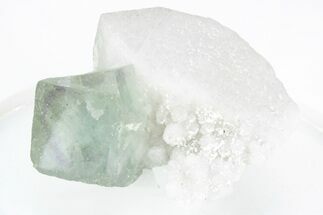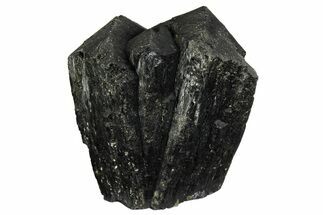This Specimen has been sold.
1.1" Quartz Crystal With Genthelvite & Loellingite - Inner Mongolia
This beautiful specimen features small orange helvite-genthelvite crystals and metallic loellingite on a quartz crystal cluster. Some of the loellingite crystals can be found as inclusions within the largest quartz crystal. It comes from the Huanggang Fe-Sn Deposit in Inner Mongolia.
About The Huanggang Mine
The "Huanggang Mine" is a complex of seven somewhat interconnected mines located near Chifeng City, Inner Mongolia, China. Incredible mineral specimens started coming out of this mining complex around 2009. However, the location provided for the specimens was a long ways away from the actual site. This is a practice commonly performed by dealers and miners following a new discovery to try and preserve the mineral site's true location, and/or for political purposes.
As the site's popularity increased, more and more fascinating specimens were popping up on the market. Some of the earlier minerals included world-class ilvaite crystals, pink fluorite octahedrons, hedenbergite-included quartz (many of which were discarded at first), and arsenopyrite. Over the following years, garnets, pink manganoan calcite, gorgeous fluorites, sphalerite, löllingite, borcarite, scheelite, and a variety of other minerals began to surface on the market. To this day, new mineral discoveries are often made in these mines.
A brief description of the mine and minerals from the Huanggang Deposit.
The "Huanggang Mine" is a complex of seven somewhat interconnected mines located near Chifeng City, Inner Mongolia, China. Incredible mineral specimens started coming out of this mining complex around 2009. However, the location provided for the specimens was a long ways away from the actual site. This is a practice commonly performed by dealers and miners following a new discovery to try and preserve the mineral site's true location, and/or for political purposes.
As the site's popularity increased, more and more fascinating specimens were popping up on the market. Some of the earlier minerals included world-class ilvaite crystals, pink fluorite octahedrons, hedenbergite-included quartz (many of which were discarded at first), and arsenopyrite. Over the following years, garnets, pink manganoan calcite, gorgeous fluorites, sphalerite, löllingite, borcarite, scheelite, and a variety of other minerals began to surface on the market. To this day, new mineral discoveries are often made in these mines.
A brief description of the mine and minerals from the Huanggang Deposit.
About Loellingite
Loellingite (or löllingite) is an iron arsenide mineral with the chemical formula FeAs₂. The crystals are often twinned and exhibit a silvery metallic luster. It is named after the Lölling mining district in Carinthia, Austria, the site from which it was first described in 1845. It typically forms in association with arsenopyrite, and it can be difficult to tell the two apart.
Toxicity Warning: Loellingite contains arsenic and can be harmful if inhaled or swallowed. Most of the risk is posed by long-term, chronic exposure to its dust or fumes. While a crystal sitting on your shelf doesn't pose a health risk, you should wash your hands after handling and keep it out of reach of children.
Loellingite (or löllingite) is an iron arsenide mineral with the chemical formula FeAs₂. The crystals are often twinned and exhibit a silvery metallic luster. It is named after the Lölling mining district in Carinthia, Austria, the site from which it was first described in 1845. It typically forms in association with arsenopyrite, and it can be difficult to tell the two apart.
Toxicity Warning: Loellingite contains arsenic and can be harmful if inhaled or swallowed. Most of the risk is posed by long-term, chronic exposure to its dust or fumes. While a crystal sitting on your shelf doesn't pose a health risk, you should wash your hands after handling and keep it out of reach of children.
About Quartz
Quartz is the name given to silicon dioxide (SiO2) and is the second most abundant mineral in the Earth's crust. Quartz crystals generally grow in silica-rich environments--usually igneous rocks or hydrothermal environments like geothermal waters--at temperatures between 100°C and 450°C, and usually under very high pressure. In either case, crystals will precipitate as temperatures cool, just as ice gradually forms when water freezes. Quartz veins are formed when open fissures are filled with hot water during the closing stages of mountain formation: these veins can be hundreds of millions of years old.
Quartz is the name given to silicon dioxide (SiO2) and is the second most abundant mineral in the Earth's crust. Quartz crystals generally grow in silica-rich environments--usually igneous rocks or hydrothermal environments like geothermal waters--at temperatures between 100°C and 450°C, and usually under very high pressure. In either case, crystals will precipitate as temperatures cool, just as ice gradually forms when water freezes. Quartz veins are formed when open fissures are filled with hot water during the closing stages of mountain formation: these veins can be hundreds of millions of years old.
SPECIES
Quartz, Helvite-Genthelvite & Loellingite
LOCATION
Huanggang Fe-Sn deposit, Chifeng City, Inner Mongolia, China
SIZE
1.1" wide
CATEGORY
ITEM
#180277
 Reviews
Reviews












